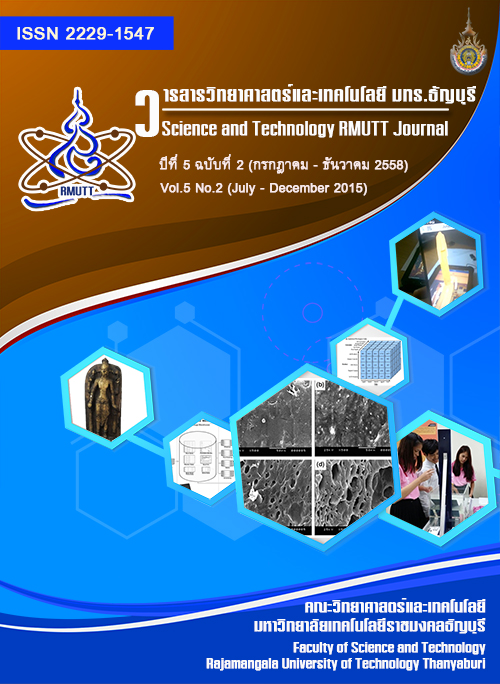Hydrophilicity improvement of natural rubber: Preparation and Characterization
Main Article Content
Abstract
Natural rubber is an important polymer which is a highly elastic material and produced from natural resource. It has thus been widely used in many applications such as tires, glove and automotive parts, etc. However, natural rubber cannot be used as water absorbing materials due to its hydrophobicity. In order to solve this weakness, the hydrophilicity of natural rubber has to be improved. This review article presents several methods to prepare the hydrophilic natural rubber by blending with the super absorbent polymers, chemical modifications and the interpenetrating polymer network technique. Also, numerous methods used to characterize the hydrophilic natural rubbers were briefly reviewed.
Article Details
References
B. Arkles. Hydrophobicity, Hydrophilicity and Silanes. Paint and Coating Industry Magazine. (2006): 114 - 132.
ว. ตานันต์ และส. แสงสุวรรณ. พอลิเมอร์ดูดซับน้ำได้มาก: การสังเคราะห์ การวิเคราะห์ และการประยุกต์ใช้. วารสารวิทยาศาสตร์และเทคโนโลยี มหาวิทยาลัยอุบลราชธานี. 16(2) (2557): 63-81.
C. Ji, S. S. Song, L. Q. Zhang, Y. P. Wu.The role of dicumyl peroxide in the preparation of chloroprene rubber/starch/sodium acrylate water-swellable composites. Carbohyd Polym. 86 (2011): 581-586.
W. Ren, Y. Zhang, Z. Peng, Y. Zhang. Investigation on the water-swelling properties of chlorinated polyethylene modified by in situ formed sodium acrylate. Polym Test. 23 (2004): 809-816.
S. S. Choi, S. H. Ha. Water swelling behaviors of silica-reinforced NBR composites in deionized water and salt solution. J Ind Eng Chem. 16 (2010): 238-242.
D. Saijun, C. Nakason, A. Kaesaman, P. Klinpituksa. Water sbsorbtion and mechanical properties of water-swellable natural rubber. Songklanakarin J Sci Tech. 5 (2009): 561-565.
C. Nakason, Y. Nakaramontri, A. Kaesaman, W. Kangwanskpamonkon, S. Kiatkamjornwong. Synthesis and characterization of water swellable rubber vulcanizates. Eur Polym J. 49 (2013): 1098 – 1110.
M. J. Zohuriaan-Mehr, H. Omidian, S. Doroudiani, K. Kabiri. Advances in non-hygienic applications of superabsorbent hydrogel materials. J Mater Sci. 45 (2010): 5711-5735.
S-N. Gan, Z. A. Hamid. Partial conversion of epoxide groups to diols in epoxidized natural rubber. Polym. 38 (1997): 1953-1956.
ส. คงทอง. ไฮโดรเจลจากการเปิดวงแหวนยางธรรมชาติอิพอกไซด์. วิจัยยางพารา. เล่มที่1 ฉบับที่ 6 (2554). 205
N. Hinchiranan, B. Suppaibulsuk, S. Promprayoon, P. Prasassarakich. Improving Properties of Modified Acrylic Sheet via Addiion of Grafted Natural Rubber. Mater. Lett. 61 (2007): 3951-3955.
C. Nakason, A. Kaesaman, P. Supasanthitikul. The grafting of maleic anhydride onto natural rubber. Polym Test. 23 (2004): 35–41.
P. Wongthong, C. Nakason, Q. Pan, G. L. Rempel, S. Kiatkamjornwong. (2013). Modification of deproteinized natural rubber via grafting polymerization with maleic anhydride. Eur Polym J. 49 (2013): 4035 – 4046.
S. Khongtong, N. Fungchonlajit. Water Swollen Natural Rubber. Walailak J Sci & Tech. 5 (2008): 57-75.
P. C. Oliveiraa, A. Guimara˜esa, J. Y. Cavaille´, L. Chazeauc, R. G. Gilbertb, A. M. Santos. Poly (dimethylaminoethyl methacrylate) grafted natural rubber from seeded emulsion polymerization. Polym. 46 (2005): 1105 – 1111.
S. Riyajan, Y. Sasithornsonti, P. Phinyocheep. (2012). Green natural rubber-g-modified starch for controlling urea release. Carbohyd Polym. 89 (2012): 251 – 258.
V. N. Pavlyuchenko, S. S. Ivanchev. Composite Polymer Hydrogels. Polym Sci. 51 (2009): 743 - 760.
J. Chen, M. Liu, H. Liu, L. Ma, C. Gao, S. Zhu, S. Zhang. Synthesis and properties of thermo- and pH-sensitive poly(diallyldimethylammonium chloride)/poly(N,N-diethylacrylamide) semi-IPN hydrogel. Chem Eng J. 159 (2010): 247-256.
J. Mohammad, Zohuriaan-Mehr, K. Kabiri. (2008). Superabsorbent Polymer Materials: A Review. Iranian Polym J. 17 (2008): 451-477.
D. Klempner, L. H. Sperling, L. A. Utracki. Interpenetrating polymer networks. 4th ed. American Chemical Society: New York. (1991)
S. Riyajan, S. Chaiponban, K. Tanbumrung. Investigation of the preparation and physical properties of a novelsemi-interpenetrating polymer network based on epoxised NR and PVA using maleic acid as the crosslinking agent. Chem Eng J. 153 (2003): 199-205.
S. Amnuaypanich, J. Patthana, P. Phinyocheep. (2009). Mixed matrix membranes prepared from natural rubber/poly(vinyl alcohol) semi-interpenetrating polymer network (NR/PVA semi-IPN) incorporating with zeolite 4A for the pervaporation dehydration of water-ethanol mixtures. Chem Eng Sci. 64 (2009): 4908 - 4918.
C. Vudjung, U. Chaisuwan, U. Pangan, N. Chaipugdee, S. Boonyod, O. Santawitee, S. Saengsuwan. Effect of Natural Rubber Contents on Biodegradation and Water Absorption of Interpenetrating Polymer Network (IPN) Hydrogel from Natural Rubber and Cassava Starch. Energy Procedia. 56 (2014): 255–26.


